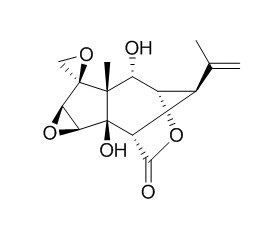Tutin
Tutin in honey, is a plant-derived neurotoxin.
Inquire / Order:
manager@chemfaces.com
Technical Inquiries:
service@chemfaces.com
Tel:
+86-27-84237783
Fax:
+86-27-84254680
Address:
1 Building, No. 83, CheCheng Rd., Wuhan Economic and Technological Development Zone, Wuhan, Hubei 430056, PRC
Providing storage is as stated on the product vial and the vial is kept tightly sealed, the product can be stored for up to
24 months(2-8C).
Wherever possible, you should prepare and use solutions on the same day. However, if you need to make up stock solutions in advance, we recommend that you store the solution as aliquots in tightly sealed vials at -20C. Generally, these will be useable for up to two weeks. Before use, and prior to opening the vial we recommend that you allow your product to equilibrate to room temperature for at least 1 hour.
Need more advice on solubility, usage and handling? Please email to: service@chemfaces.com
The packaging of the product may have turned upside down during transportation, resulting in the natural compounds adhering to the neck or cap of the vial. take the vial out of its packaging and gently shake to let the compounds fall to the bottom of the vial. for liquid products, centrifuge at 200-500 RPM to gather the liquid at the bottom of the vial. try to avoid loss or contamination during handling.
Redox Rep.2024, 29(1):2392329.
Heliyon.2024, 10(7):e28755.
Preprints2017, 2017120176
J Appl Biol Chem.2024, 67:33,238-244
Crystals2020, 10(3), 206.
Curr Top Med Chem.2020, 20(21):1898-1909.
Clin Exp Pharmacol Physiol.2015, 42(11):1189-97
J Pharmacopuncture.2023, 26(4):357-365.
J Ethnopharmacol.2023, 321:117501.
Molecules.2019, 24(1):E159
Related and Featured Products
J Nat Prod. 2015 Jun 26;78(6):1363-9.
Sweet Poisons: Honeys Contaminated with Glycosides of the Neurotoxin Tutin.[Pubmed:
25993882]
Poisonings due to consumption of honeys containing plant toxins have been reported widely. One cause is the neurotoxin Tutin, an oxygenated sesquiterpene picrotoxane, traced back to honeybees (Apis mellifera) collecting honeydew produced by passionvine hoppers (Scolypopa australis) feeding on sap of the poisonous shrub tutu (Coriaria spp.). However, a pharmacokinetic study suggested that unidentified conjugates of Tutin were also present in such honeys.
METHODS AND RESULTS:
We now report the discovery, using ion trap LC-MS, of two Tutin glycosides and their purification and structure determination as 2-(β-d-glucopyranosyl)Tutin (4) and 2-[6'-(α-d-glucopyranosyl)-β-d-glucopyranosyl]Tutin (5). These compounds were used to develop a quantitative triple quadrupole LC-MS method for honey analysis, which showed the presence of Tutin (3.6 ± 0.1 μg/g honey), hyenanchin (19.3 ± 0.5), Tutin glycoside (4) (4.9 ± 0.4), and Tutin diglycoside (5) (4.9 ± 0.1) in one toxic honey. The ratios of 4 and 5 to Tutin varied widely in other Tutin-containing honeys.
CONCLUSIONS:
The glycosidation of Tutin may represent detoxification by one or both of the insects involved in the food chain from plant to honey.
Food Chem Toxicol. 2014 Oct;72:234-41.
Human pharmacokinetic study of tutin in honey; a plant-derived neurotoxin.[Pubmed:
25084484]
Over the last 150 years a number of people in New Zealand have been incapacitated, hospitalised, or died from eating honey contaminated with Tutin, a plant-derived neurotoxin.
METHODS AND RESULTS:
To investigate the basis of this variability a pharmacokinetic study was undertaken in which 6 healthy males received a single oral dose of Tutin-containing honey giving a Tutin dose of 1.8 μg/kg body weight. The serum concentration-time curve for all volunteers exhibited two discrete peaks with the second and higher level occurring at approximately 15 h post-dose. Two subjects reported mild, transient headache at a time post-dose corresponding to maximum Tutin concentrations. There were no other signs or symptoms typical of Tutin intoxication such as nausea, vomiting, dizziness or seizures. Pharmacokinetic analysis using a two-site absorption model resulted in a good fit to the observed concentration data.
CONCLUSIONS:
A novel analytical method subsequently revealed the presence of glycoside conjugates of Tutin in addition to unconjugated Tutin in honey. These pharmacokinetic data will be important to better define a safe maximum Tutin concentration in honey.



